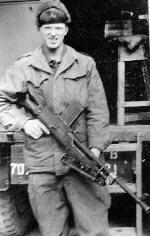-
Legacy Member

Reflections of an Ordnanceman - Bob Faris
Korean War Educator: Memoirs - Bob Faris

Bob Faris pictured with a Canadian -made Bren light machine gun in 7.92mm caliber.
-made Bren light machine gun in 7.92mm caliber.
In the discussion thread about M1 Carbines in American Rifleman Magazine I had recalled an article written about weapons in Korea and the experiences of an armorer. It took awhile to remember the site, and a few more hours of skimming memoirs of other servicemen to find it, but I have located the insightful gem.
Carbines in American Rifleman Magazine I had recalled an article written about weapons in Korea and the experiences of an armorer. It took awhile to remember the site, and a few more hours of skimming memoirs of other servicemen to find it, but I have located the insightful gem.
I am not looking to use this as any sort of discussion breaker on the M1 carbine, but for the historical value of the very detailed account of Robert Faris, so I have placed it in the general discussion forum.
Some interesting excerpts:
The BAR - Susceptible to Dry, Cold, and Dust
I will try to briefly describe problems with the other principal small arms in use. Problems with BAR barrels have already been described. Other problems were located in the trigger group, buffer group, and the bolt operating group. Trigger group components such as the sear, connector, sear release stop lever, trigger, and low cyclic rate components are served by a flat sear spring, with three prongs. Unless the trigger assembly is kept well lubricated the sear will fail to trip and release the operating slide and bolt assembly, or fail to re-engage when the trigger is released. It would not return the trigger and connector, when dry, and/or too cold or contaminated with dust, etc. Bending the three prongs to increase the preload often helped. The low rate mechanism in the trigger group and the accelerator and actuator within the buffer tube generally would be slowed down by the same adverse conditions, until the actuator would not hit the sear release hard enough to release the sear. I often re-assembled the buffer head up-side down, so that only high rate and semi-automatic were available, which worked more reliably than high rate and low rate.
The same field conditions would cause the buffer cups and cones to stick or jam to the rear, thus negating buffer action, which was hard on the gun. Dusty conditions aggravated wear between the piston head and the gas cylinder. The piston head ring gauge tended to give a false "OK" indication if the piston head was worn egg-shaped. Too much gas blow-by reduced the force acting on the piston to cycle the piston, slide and bolt assembly to the rear. The same problem existed with the plug gauge for the gas cylinder body.
The last major problem was correction of excess headspace. Because of no headspace adjustment, nor any component such as bolts being available in small incrementally-variable lengths, this condition was correctable in the field only by trying a new bolt, bolt lock, bolt link, or combination thereof. We did not have the facilities or time to install a bolt-lock headspacing adjusting-plate, as per TB Ordnance 366. If none of the new components described corrected the problem, the gun was condemned, and turned in.
and
Lubricant Problems
I was shocked at the condition of most of the machine guns. They looked all right and well cared for except for one thing. Most of them were "frozen up." After I wrestled the bolts to the rear the recoil springs would barely push the bolts back into battery. I was told why. It seems that (as I confirmed later) there was practically no PL SP light gun oil in the outfit, nor hardly anywhere else in the Division, so the troops were told to use #10 weight motor oil, but that was too thick in the cold. Then they were told to dilute the motor oil with gasoline. Of course when the gasoline evaporated you were back to #10 weight motor oil. So, they diluted the oil with kerosene. That worked a little better, but it had to be lightly applied and they had not yet got the right mix. Alternatively, they would leave the weapon dry, but with the combination of the cold and ever-present dust, that didn't work well either. These tankers weren't too concerned, because they had been dug in for long-range H.E. fire support for the infantry with their 90mm (M26-46 Pershing) and 76mm (M4A3E8 Sherman) cannon. As I was to soon learn, the lubricant problem also applied to the individual weapons; i.e., M1 Garands, M1 and M2 carbines, and M3 and M3A1 sub machine guns, and to a lesser extent M1911A1 pistols. I recommended that they clean up a couple of sluggish guns with gasoline, as they had no solvent. I left a can of PL SP oil, and told them to apply it lightly.
I encourage everyone interested to take the time and give the account a read.
Information
 |
Warning: This is a relatively older thread
This discussion is older than 360 days. Some information contained in it may no longer be current. |
|
Last edited by Sentryduty; 01-26-2016 at 04:47 PM.
- Darren
1 PL West Nova Scotia Regiment 2000-2003
1 BN Princess Patricia's Canadian Light Infantry 2003-2013
-
The Following 2 Members Say Thank You to Sentryduty For This Useful Post:
-
01-26-2016 03:17 PM
# ADS
Friends and Sponsors

-made Bren light machine gun in 7.92mm caliber.
Carbines in American Rifleman Magazine I had recalled an article written about weapons in Korea and the experiences of an armorer. It took awhile to remember the site, and a few more hours of skimming memoirs of other servicemen to find it, but I have located the insightful gem.
















 PM
PM






